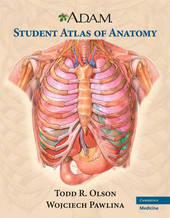
|
A.D.A.M. Student Atlas of Anatomy
Paperback / softback
Main Details
| Title |
A.D.A.M. Student Atlas of Anatomy
|
| Authors and Contributors |
By (author) Todd R. Olson
|
|
By (author) Wojciech Pawlina
|
| Physical Properties |
| Format:Paperback / softback | | Pages:512 | | Dimensions(mm): Height 280,Width 215 |
|
| Category/Genre | Anatomy |
|---|
| ISBN/Barcode |
9780521710053
|
| Classifications | Dewey:611 |
|---|
| Audience | | Tertiary Education (US: College) | | Professional & Vocational | |
|---|
| Edition |
2nd Revised edition
|
| Illustrations |
40 Tables, unspecified; 25 Line drawings, unspecified; 750 Line drawings, color
|
|
Publishing Details |
| Publisher |
Cambridge University Press
|
| Imprint |
Cambridge University Press
|
| Publication Date |
7 April 2008 |
| Publication Country |
United Kingdom
|
Description
Renowned for its innovative approach to understanding the human body, this second edition features full-color art throughout, using a three-dimensional approach to anatomic structure. Emphasizing surface anatomy, it features unique additional views (posterior, medial, lateral) of important structures with extensive coverage of those areas - such as the perineum, head, and neck - which are often difficult for students to understand and appreciate. The ADAM Student Atlas of Anatomy is an invaluable learning and review tool developed for medical, allied health, and human biology undergraduate and graduate students.
Author Biography
Todd R. Olson is Professor of Anatomy and Structural Biology and Director of Medical Gross Anatomy at the Albert Einstein College of Medicine, New York. Wojciech Pawlina is Professor and Chair of the Department of Anatomy at the Mayo Clinic College of Medicine.
Reviews"By including both systemic coverage of the body and regional approaches, the authors reach both undergraduate medical students and allied health students....This anatomy atlas covers each significant region of the human body in detail appropriate for reduced-hours medical curricula, as is the case in many major medical schools. In addition to the regional treatment of the human body, a standard for most anatomical atlases, the authors also present a systemic treatment of the body, carefully woven into the regional anatomy approach. In effect, the authors are able to target two different audiences with their unique style and approach. In addition, the detailed regional illustrations with only the most clinically relevant structures labeled are juxtaposed with cadaveric dissection photos. The authors stress the significance of including cadaver photos, explaining that many students prefer to use illustrations that resemble their own dissections, but usually only as a refresher before exams. Thus, by including traditional illustrations and photographs, the authors have eliminated the need to purchase more than one anatomy atlas for studying....This is an impressive student atlas." --Doody's Review Service
|